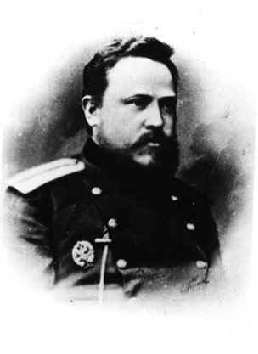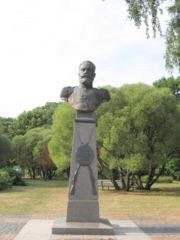|
Colonel
Sergei Ivanovich Mosin

The Rifle Mosin or it's
western name, the Mosin Nagant rifle owes it's beginnings to the
circumstance of modern warfare. The advent of the repeating rifle led
the Russian Imperial government to start a search for a replacement for
their antiquated Berdans. A commission was established to find a design
that would compete with the Mauser, Lebel, Lee-Medford,
Mannlicher, Schmidt-Rubin and the Krag-Jorgensen. They could
have never imagined that the result of their efforts would see service
in battle for the next 80 years while the other rifles became museum
pieces. A Russian army Captain, Sergei Ivanovich
Mosin would eventually produce the winner of the competition for a new
design.
Mosin's rifle wasn't an overnight success. He began work on the design
in 1883. His primary focus was on the development of a magazine fed
infantry rifle. He submitted several designs for internal fed magazine
rifles to the commission in 1884 and 1885. His initial designs were in
10.6 mm. Between 1887 and 1889, working with the smaller
calibers then coming into general use among European armies, Mosin
developed a 5-shot, straight-line magazine prototype in 7.62 mm;
employing the antediluvian Russian measurements of the era it was
designated 3-line caliber. The liniya, or line is equivalent to 0. 10
in or 2.54 mm; therefore, 3 linii equals 7.62 mm or .30 in.(Lapin, "The
Mosin Nagant Rifle")
All of his efforts were
rejected until October 1889. The Belgian weapons designer Leon Nagant
submitted his 3.5 line (8.89 mm) rifle and 500 rounds of ammunition for
testing by the Russian government. Both designers' weapons were tested
from 1890 through 1891 by units of the Russian Army. Initially, the
home team headed by Mosin lost as the army favored Nagant's design.
However, Russia being Russia, the votes were overturned in favor of
Mosin. The reason behind this move was most likely political. Typical
of Russian ingenuity and political deftness, both designs were
incorporated into a rifle that featured the Mosin model with the Nagant
designed feed system. This rifle was designated the Pekhotniya vintovka
obr. 1891g. or Three-Line Rifle of the year 1891. The rifle was entered
into production in 1892 at the arsenal in Chatellerault under contract
and later in Russia at the Ishevsk and Sestroretsk arsenals.
Sergei Ivanovich Mosin
(pronouced "Moi-seen") was born My 5, 1849. He entered into a military
academy at age 12 where he excelled as a soldier. In 1867, he entered
the Alexandrovskoye Military High School in Moscow. Upon leaving
Alexandrovskoye in 1870, he decided to go to the artillery branch and
transferred to the Mikhailovskoye Artillery Academy. He graduated in
1875 and transferred to the Tula Arsenal where he became the head of
the machining division. It was here he began his career as a weapons
designer by first making improvements to the Berdan II and later the
collaboration with Nagant to design the Rifle of Three Lines of the
Year 1891. Mosin eventually rose to the rank of Colonel and was
appointed as the director of the Sestroretsk arsenal. He died on
February 8, 1902 and was buried in Tula.
|

